
10 Stand Out Books to Transform Your Marketing in 2025
Ready to Reimagine Your Marketing?
Last updated: April 20, 2025
In today’s competitive market, simply keeping up isn’t enough. For CTOs, CEOs, startup founders, and entrepreneurs, understanding modern marketing is crucial for both survival and growth. Marketing has changed drastically, from the early days of mass media to today’s digital platforms and personalized experiences.
Old marketing strategies are no longer effective. Holding onto outdated approaches can lead to stagnation. So how do you navigate this complex landscape and create genuine connections with measurable results?
Effective marketing now depends on a few key factors. These include a deep understanding of your customer, data-driven decisions, and a willingness to experiment. It’s about building brands that resonate with your audience, crafting compelling stories, and consistently delivering value.
This requires a shift in how we think about marketing. We need to move beyond traditional transactional approaches and focus on building meaningful, long-term relationships. The foundational theories of consumer behavior, combined with newer growth hacking strategies, provide a valuable framework for navigating modern marketing. These concepts are discussed in detail across several influential marketing books.
Mastering Modern Marketing
From consumer behavior to innovative tactics, these books offer a guide to the art and science of marketing. They provide a timeless yet relevant approach to understanding the customer journey and maximizing impact. Be prepared to challenge your assumptions, expand your skillset, and unlock the potential of truly effective marketing strategies.
How To Stand Out: Building a Following Around Your Breakthrough Idea
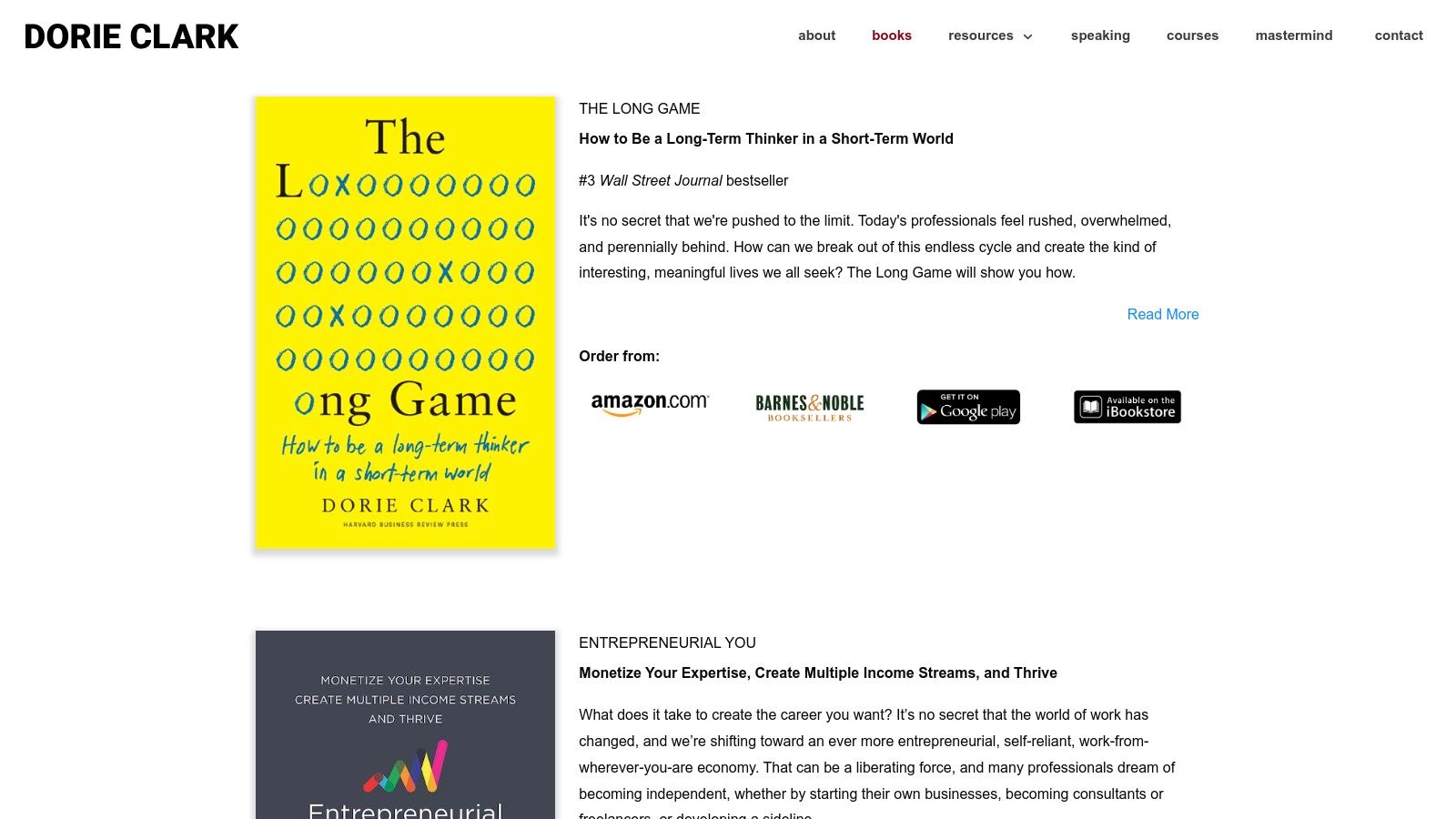
For leaders in the tech and startup world, building thought leadership is essential. This attracts talent, investors, and customers. Dorie Clark’s “Stand Out: How to Find Your Breakthrough Idea and Build a Following Around It” offers a practical guide to achieving this. This book provides a clear framework for developing your personal brand and gaining recognition.
This book goes beyond surface-level advice. It digs into the specifics of identifying your area of expertise. It also guides you on creating compelling content and sharing it strategically. Clark combines thorough research, interviews with successful thought leaders, and practical exercises to help you along the way.
Key Features and Benefits
- Structured Idea Development: The book provides a step-by-step process for identifying your unique strengths. You’ll learn to use these strengths to create resonant ideas. This is particularly helpful for startup founders disrupting existing markets.
- Brand Building Strategies: The book offers a variety of tools for building a loyal following. These range from online platforms like social media and blogging to offline tactics like speaking engagements and networking.
- Real-World Examples: Learn from case studies of successful thought leaders. These examples offer inspiration and show the book’s principles in action.
- Practical Application: The book includes actionable exercises. This helps you apply the concepts to your own circumstances, ensuring you see tangible results.
- Content Repurposing: Learn how to extend the reach of your content. The book covers repurposing across multiple platforms, a valuable strategy for busy entrepreneurs.
Pros and Cons
Here’s a quick overview of the book’s strengths and weaknesses:
| Pros | Cons |
|---|---|
| Actionable advice and real-world examples | Some strategies require significant time commitment |
| Applicable methodology across industries | Can be challenging for introverted personalities |
| Includes both online and offline strategies | Some case studies might feel dated |
| Written in an accessible and engaging style |
Putting It Into Practice
Here are a few tips for implementing the book’s strategies:
- Self-Assessment: Start by identifying your strengths and passions. This is the foundation of a strong personal brand.
- Focused Approach: Don’t try to do everything at once. Begin with one or two key strategies that suit your strengths and available resources.
- Consistency is Key: Building a following takes time and consistent effort. A content calendar can help you stay on track.
- Track and Adjust: Monitor your results and adapt your strategy based on what’s working and what’s not.
Visit Dorie Clark’s Website for more information about her books.
The book’s price varies by retailer and format. However, it’s a valuable investment for leaders who want to increase their influence. The book has no technical requirements. “Stand Out” offers a unique, actionable framework and focuses on developing fresh ideas. This makes it an excellent resource for those seeking to create a lasting impact.
2. Purple Cow: Transform Your Business By Being Remarkable
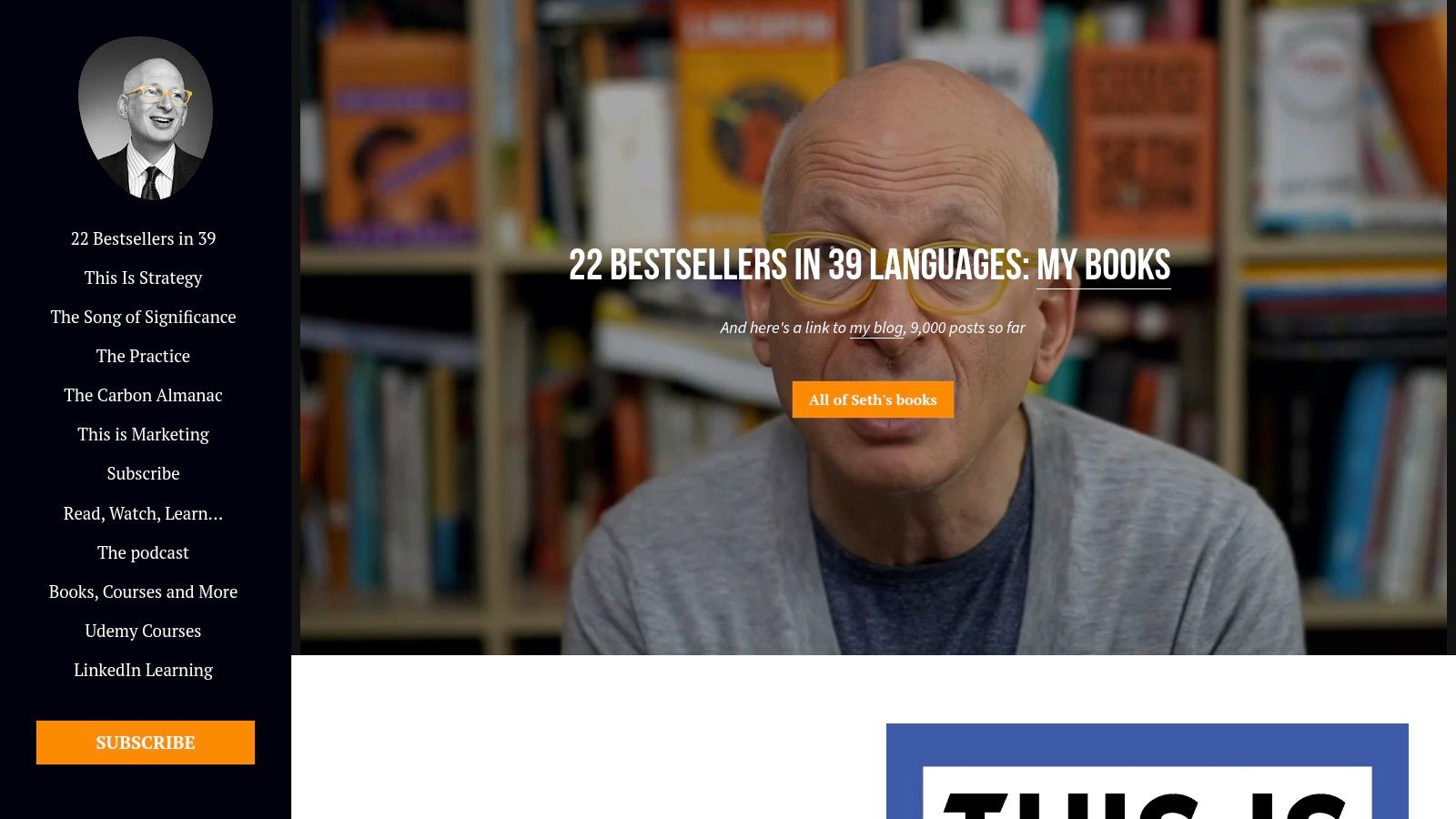
For CTOs, CEOs, startup founders, and entrepreneurs looking to make a real impact, Seth Godin’s Purple Cow: Transform Your Business by Being Remarkable is essential reading. This book advocates for a fundamental shift in how we think about marketing: ditch the ordinary and become remarkable. In a world overflowing with options, playing it safe is actually the biggest risk.
Purple Cow challenges traditional mass marketing strategies. It champions the creation of inherently remarkable products and services that generate their own buzz.
Why “Purple Cow” Matters
In a market saturated with similar products, traditional marketing often fails. Purple Cow argues that cutting through the noise requires being inherently remarkable – something worth talking about. This resonates particularly with startups and innovative companies looking to disrupt existing markets.
The focus shifts from large marketing budgets to creating products and services so unique and compelling that they essentially market themselves.
Key Features and Benefits
- Framework for Remarkable Products: Godin provides a framework for identifying and developing products that truly stand out. He encourages readers to think differently about product development, pushing beyond incremental improvements towards genuinely innovative solutions.
- Case Studies: The book is packed with real-world examples of companies that have successfully embraced the “purple cow” philosophy, demonstrating the power of remarkability across various industries.
- Practical Advice for Differentiation: While focusing on the conceptual shift, the book also offers practical tips on differentiating your offerings and finding your unique “purple cow.”
- Word-of-Mouth Marketing: Godin highlights the importance of word-of-mouth marketing, especially in the age of social media, and provides strategies for leveraging this powerful tool.
- Modern Marketing Tactics: Recognizing the declining effectiveness of traditional advertising, Purple Cow explores alternative strategies better suited for today’s consumer.
Pros and Cons of “Purple Cow”
Let’s look at the strengths and weaknesses of Godin’s approach:
| Feature | Description |
|---|---|
| Pros: | |
| Core Concept | Concise and memorable, making the book’s message stick. |
| Real Examples | Numerous case studies illustrate the concept and inspire readers. |
| Fresh Thinking | Challenges conventional marketing wisdom with a thought-provoking perspective. |
| Quick Read | High-impact message delivered concisely. |
| Cons: | |
| Outdated Examples | Some cited examples may not resonate with the current market. |
| Implementation | Light on concrete implementation guidance. |
| Oversimplification | Can sometimes oversimplify complex market dynamics. |
Implementation Tips
- Brainstorming: Use the “purple cow” concept to brainstorm with your team. Challenge yourselves to find ways to make your product or service truly remarkable.
- Customer Feedback: Gather feedback from your target audience to understand what they find unique and valuable.
- Iteration: Don’t be afraid to experiment and iterate on your offerings. Finding your “purple cow” is an ongoing process.
Purple Cow Website
While Purple Cow might not offer a step-by-step guide to marketing success, it offers a powerful and essential shift in thinking for anyone looking to create truly remarkable products and services. Its value lies in challenging conventional thinking and inspiring innovative marketing approaches. This is a valuable resource for anyone looking to differentiate themselves in a competitive market.
Made To Stick: Communicating Effectively
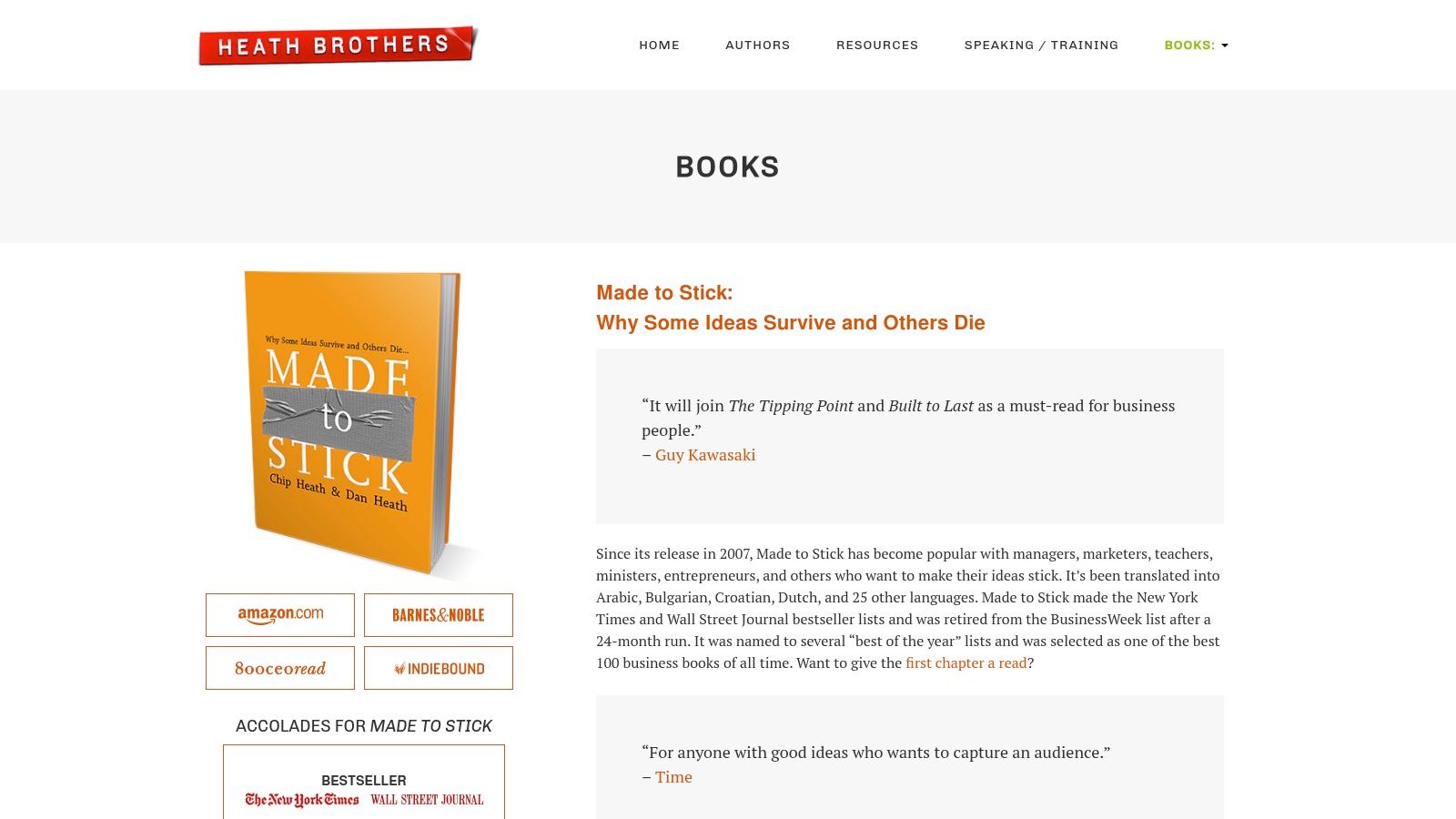
Clear communication is essential for leaders, especially CTOs, CEOs, startup founders, and entrepreneurs. Whether you’re pitching investors, motivating your team, or engaging customers, your message must be impactful. Chip and Dan Heath’s book, Made to Stick: Why Some Ideas Survive and Others Die, provides a valuable framework for achieving this.
This book stands out due to its practical, research-based approach to crafting communications that truly resonate. It provides a simple yet powerful framework – SUCCESS – for building memorable and persuasive messages.
The SUCCESS Framework
The SUCCESS framework provides six key principles for making your ideas stick:
- Simple: Get to the core of your message. For example, a startup founder might simplify a complex technology into a clear value proposition.
- Unexpected: Capture attention by surprising your audience. A CTO explaining a new system could use an analogy to make it relatable.
- Concrete: Use specific language and imagery. Instead of discussing abstract “efficiency,” a CEO might quantify impact with real-world data.
- Credible: Support claims with evidence. Entrepreneurs can strengthen pitches with data, testimonials, or pilot program results.
- Emotional: Connect with your audience on a personal level. A founder sharing their story can resonate with potential investors.
- Stories: Frame your message within a narrative. A compelling customer story is often more persuasive than a list of features.
Beyond the Framework
“Made to Stick” goes beyond just the SUCCESS framework, exploring the psychology behind memorable ideas. It uses diverse case studies to illustrate these principles and offers practical techniques for applying them. There are even templates for crafting sticky messages.
Pros and Cons of “Made To Stick”
Here’s a breakdown of the book’s strengths and weaknesses:
| Pros | Cons |
|---|---|
| Research-backed strategies | Some concepts overlap with other marketing texts |
| Applicable across various fields | Can feel formulaic if applied too rigidly |
| Engaging storytelling | Requires creativity for effective implementation |
| Clear, actionable framework (SUCCESS) |
Accessibility and Value
The book’s insights are valuable for any leader aiming to communicate effectively. Regardless of format (physical book, ebook, or audiobook), “Made to Stick” offers valuable lessons. No technical expertise is required to benefit from this book, making it accessible to anyone wanting to improve their communication. By understanding and applying these principles, you can transform your ideas from forgettable to memorable, gaining a significant edge.
Steal Like An Artist: A Creative Boost For Business Leaders
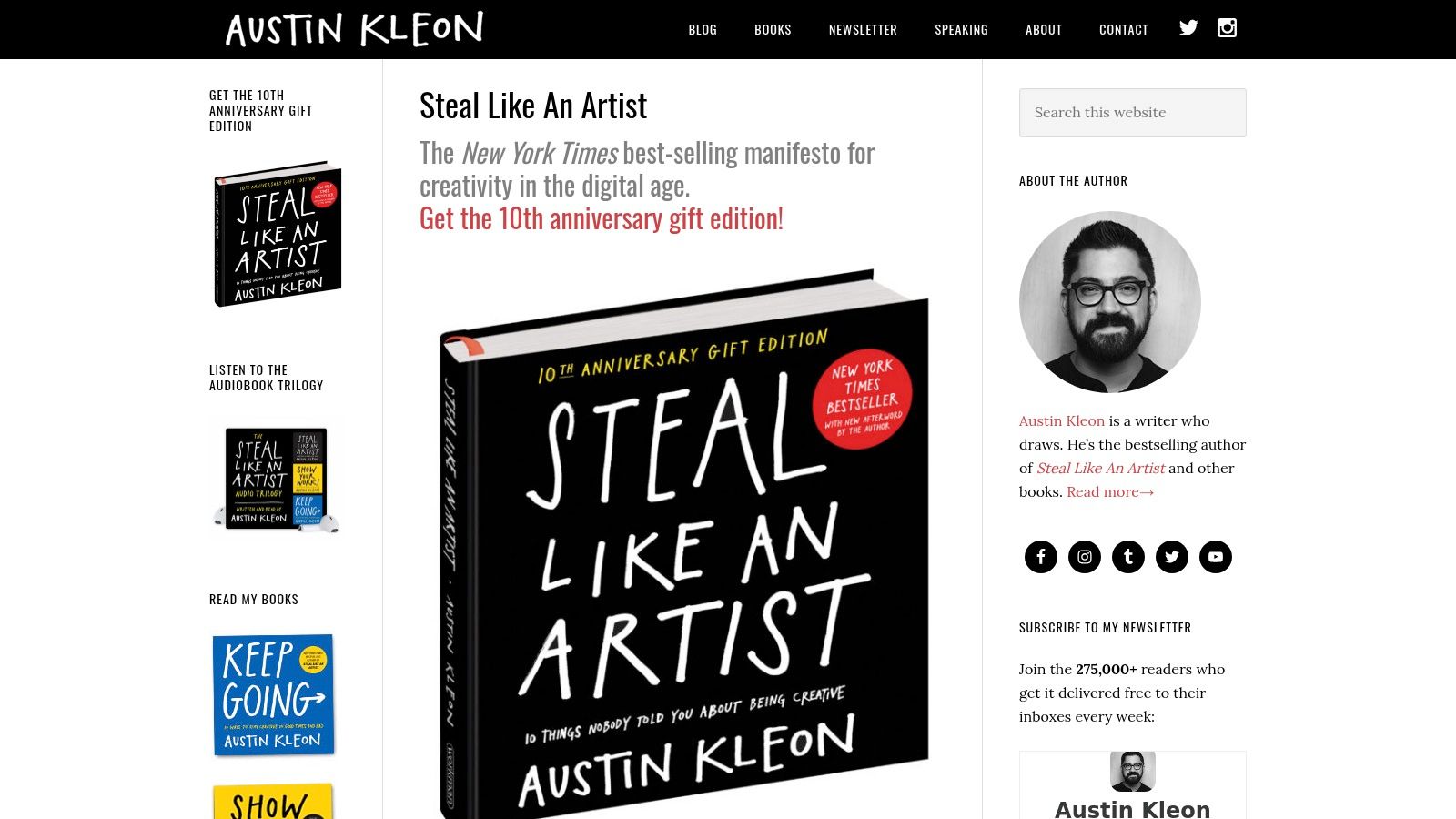
Austin Kleon’s Steal Like an Artist isn’t just a book; it’s a fresh perspective on creativity. It’s a helpful resource for anyone struggling with creative blocks, especially busy leaders like CTOs, CEOs, startup founders, and entrepreneurs. The book offers a practical approach to fostering creativity, a crucial skill for those constantly seeking innovative solutions. Kleon’s core message is that creativity thrives on embracing influence, connecting ideas, and remixing inspiration to create something new.
Practical Applications For Business Leaders
- Idea Generation & Innovation: Kleon’s “steal like an artist” philosophy encourages looking beyond conventional thinking. By inspiring teams to draw from diverse sources and blend seemingly unrelated concepts, businesses can cultivate innovation. This leads to the development of unique products, services, and marketing strategies.
- Building A Strong Brand Identity: Finding your unique voice and sharing your work authentically are key to establishing a strong brand. This is particularly important for startups trying to stand out in a competitive market. Steal Like an Artist offers practical guidance on achieving this.
- Improving Team Collaboration And Communication: The principles of sharing, remixing, and giving credit where it’s due can significantly improve team dynamics. Openly sharing ideas and acknowledging individual contributions fosters a more collaborative and productive environment.
- Content Creation And Marketing: Kleon’s advice on effectively sharing work in the digital age offers valuable insights for content marketing. Building a genuine online presence and connecting with your audience is crucial in today’s social media landscape.
Features And Benefits
- Ten Principles For Unlocking Creativity: The book provides a clear framework for navigating the creative process, from finding inspiration to sharing your finished work.
- Techniques For Finding Inspiration: Kleon offers practical exercises for cultivating curiosity and drawing inspiration from everyday life and various fields.
- Methods For Developing Creative Habits: Steal Like an Artist emphasizes the importance of regular creative practice. It provides strategies for establishing sustainable habits.
- Strategies For Sharing Work Effectively: The book offers actionable advice on building an online presence, engaging your audience, and sharing your work ethically while building your brand.
- Visually Engaging Presentation: The illustrated format makes it an enjoyable and accessible read, perfect for busy individuals.
Pros & Cons
- Pros: Concise and easy to understand, inspirational and practical, visually appealing, applicable to various creative fields.
- Cons: May be too basic for experienced creatives, some advice might seem obvious to seasoned professionals, the short length limits deeper exploration of certain topics.
Pricing And Availability
- Available in various formats (physical, ebook, audiobook) from major online retailers like Amazon. Prices vary.
Similar Resources
- Show Your Work! by Austin Kleon (focuses on sharing your creative process)
- Keep Going by Austin Kleon (emphasizes maintaining momentum and overcoming creative blocks)
- The War of Art by Steven Pressfield (addresses resistance to creative work)
Implementation Tip
Gift Steal Like an Artist to your team and facilitate a discussion around its key principles. This can spark valuable conversations about creativity and innovation within your organization.
Website
https://austinkleon.com/steal/
This book is a valuable tool for anyone wanting to cultivate a more creative mindset and develop effective strategies for sharing their work. Its concise and practical approach makes it a worthwhile read for busy leaders seeking to bring more innovation and creativity into their work.
Positioning Your Product: Winning the Minds of Your Customers
In a crowded marketplace, getting your message heard by the right people is a significant challenge. “Positioning: The Battle for Your Mind” by Al Ries and Jack Trout offers a proven framework for achieving just that. This marketing essential introduces the idea of positioning – influencing how potential customers perceive your product. It’s about crafting a clear, concise, and persuasive message that resonates with your audience and solidifies your brand in their memory. This book remains invaluable because its core principles hold true even in today’s dynamic market.
Why Positioning Matters for Business Leaders
Whether you’re launching a new product, entering a new market, or simply seeking a competitive advantage, understanding positioning is paramount. For CTOs, this means developing products that align with the intended market position. CEOs can use positioning to steer overall business strategy. Startup founders can define their niche and attract early adopters. And entrepreneurs can build strong, recognizable brands.
Key Features and Benefits of “Positioning”
- A Practical Framework for Positioning: The book provides a step-by-step guide to analyzing your market, understanding your competitors, and developing a unique position that connects with your target audience.
- Strategies for Achieving Market Leadership: Discover how to position your product as the leader in its category, even if you’re not the first to market.
- Effective Competitive Analysis: Learn how to analyze your competitors’ positioning and uncover opportunities to set yourself apart.
- Managing Brand Perception: Take control of the narrative surrounding your brand and influence how customers perceive your products or services.
- Real-World Examples of Successful Positioning: Gain insights from case studies of companies that have effectively leveraged positioning to achieve market dominance.
Pros of Reading “Positioning”
- Enduring Principles: The core concepts of positioning remain highly relevant in today’s marketplace, despite the book’s original publication in 1981.
- Clear and Concise Writing: The book is easily digestible, even for those without a background in marketing.
- A Groundbreaking Approach to Marketing: This work has fundamentally altered how companies approach marketing and brand building.
- Universally Applicable: Whether you’re a small startup or a large corporation, the principles of positioning can contribute to achieving your marketing objectives.
Cons to Consider
- Dated Examples: Some of the specific examples may feel a little outdated.
- Limited Digital Context in Older Editions: Opt for a more recent edition to gain updated perspectives on the digital landscape.
- Potential Oversimplification: Market dynamics can be complex. While positioning is a powerful tool, it’s essential to acknowledge this complexity.
Tips for Implementing Positioning Strategies
- Begin with Comprehensive Competitive Analysis: Before defining your position, thoroughly analyze your competitors’ strengths, weaknesses, and market perception.
- Embrace Simplicity: A clear and concise message is crucial for cutting through the noise.
- Maintain Consistency: Once you’ve defined your position, ensure your marketing efforts consistently reinforce that message.
Pricing and Availability
“Positioning” is available online and in bookstores. Pricing varies depending on the format (print, ebook, audiobook). Positioning: The Battle for Your Mind
Comparison with Other Marketing Books
While many marketing books address branding and differentiation, “Positioning” focuses specifically on establishing your product in the customer’s mind, providing a uniquely impactful framework.
This book is more than just a good read; it’s a crucial investment in creating a lasting brand. By understanding and implementing the principles of positioning, you can differentiate yourself from competitors, connect with your target audience, and win the battle for their attention.
Finding Your Difference: A Review of Bernadette Jiwa’s Marketing Guide
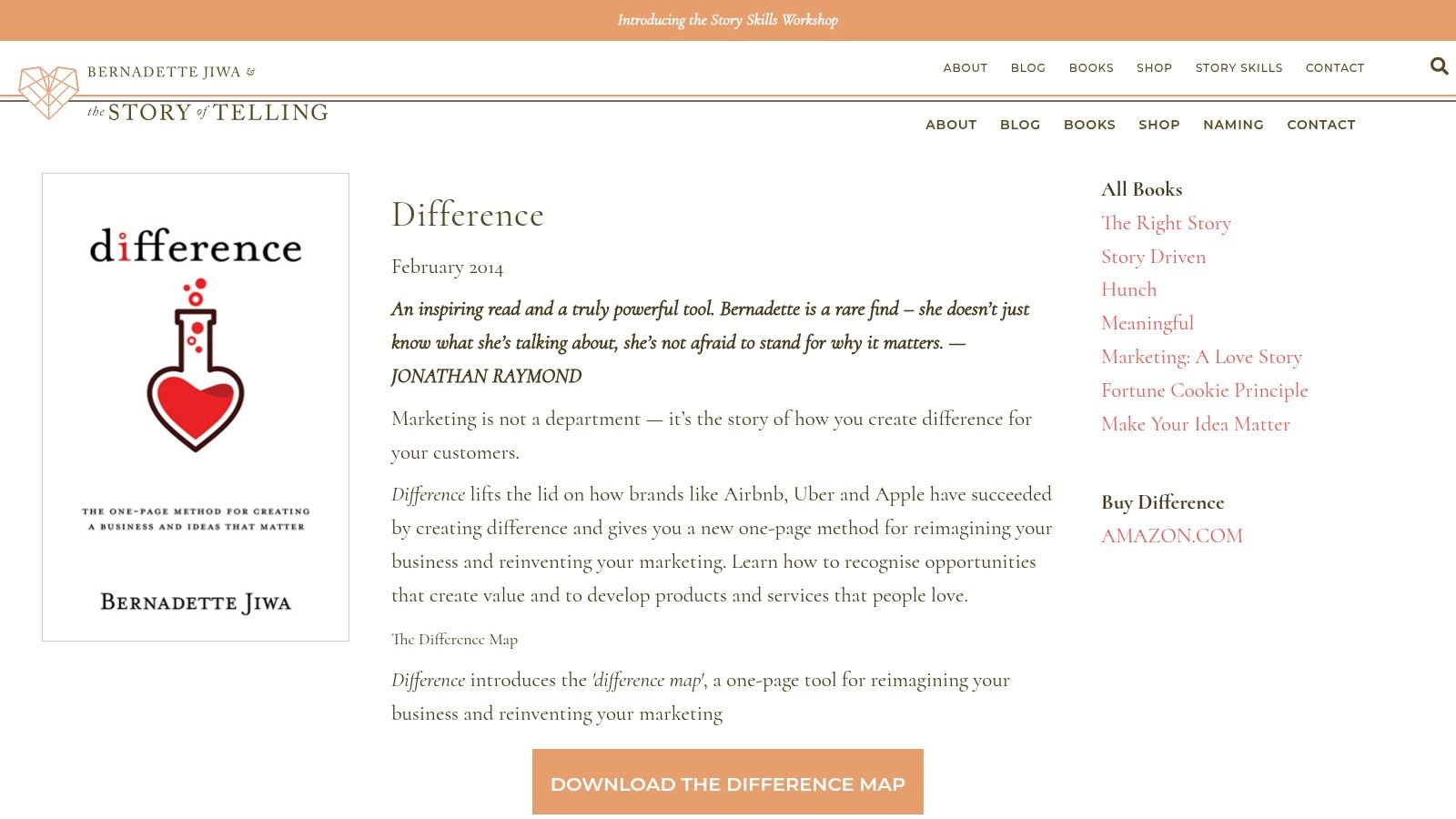
Bernadette Jiwa’s Difference: The One-Page Method for Reimagining Your Business and Reinventing Your Marketing offers a refreshing approach for those looking to make a real impact. Aimed at CTOs, CEOs, startup founders, and entrepreneurs, this book provides a practical framework for navigating the challenges of a competitive market. Central to this framework is the “Difference Map,” a one-page tool designed to help businesses pinpoint and articulate their unique value.
This isn’t your typical marketing guide. Instead of focusing on surface-level features and benefits, Jiwa emphasizes understanding the emotional drivers behind customer decisions. This customer-centric approach helps businesses connect with their target audience on a much deeper, more meaningful level. The book guides readers through a process of discovering what truly resonates with their customers and translating those insights into compelling brand stories.
Key Features and Benefits
- One-Page Difference Map Methodology: This straightforward yet powerful tool offers a structured way to define your unique value proposition. It helps you articulate how your product or service addresses specific customer needs, particularly focusing on the emotional aspects.
- Focus on Emotional Value Creation: The book underscores the importance of understanding your target market’s emotional landscape. By identifying the feelings your product or service evokes, you can craft marketing messages that truly resonate.
- Customer-Centered Innovation Framework: Difference encourages a shift towards customer-centricity, promoting innovation driven by a deep understanding of customer needs and aspirations.
- Brand Storytelling Techniques: Jiwa offers practical guidance on creating compelling narratives that connect with your target audience and communicate the emotional value you offer.
- Implementation Exercises and Questions: The book includes practical exercises and insightful questions to help you implement the Difference Map and develop a truly differentiated brand.
Pros and Cons of Difference
Pros:
- Practical and Applicable Methodology: The Difference Map provides a tangible framework easily applied to various business situations.
- Emphasis on Customer Empathy: The book champions a customer-centric approach, encouraging businesses to prioritize understanding their target audience’s emotional needs.
- Concise and Actionable Format: Difference is straightforward and easy to read, allowing for quick implementation of key concepts.
- Suitable for Businesses of All Sizes: Whether you’re a startup or a large organization, the principles presented in Difference can be adapted to your specific requirements.
Cons:
- Potential Oversimplification for Complex Organizations: Larger organizations with intricate structures might need additional tools and strategies to fully implement the framework.
- Requires Thorough Customer Research: The Difference Map’s effectiveness depends on a deep understanding of your customer base, necessitating dedicated research and analysis.
- Limited Technical Marketing Tactics: The book focuses primarily on strategic differentiation rather than specific technical marketing execution.
Tips for Implementing the Difference Map
- Invest Time in Customer Research: Don’t rush the process. Thorough research is crucial to uncover your customers’ true needs and motivations.
- Encourage Team Collaboration: Engage your team in the Difference Map exercise to ensure buy-in and gather diverse perspectives.
- Regularly Review and Refine: Customer understanding evolves over time. Revisit and refine your Difference Map as needed.
Where to Find Difference
You can learn more about the book on Bernadette Jiwa’s website: https://thestoryoftelling.com/difference/. While pricing isn’t listed on the site, Difference is widely available from major online retailers. The methodologies don’t require any specific technical setup. Compared to tools like the Value Proposition Canvas or Business Model Canvas, Difference emphasizes the emotional drivers of customer decisions, making it a valuable resource for any entrepreneur.
7. Blue Ocean Strategy: Charting a Course to Uncontested Market Space
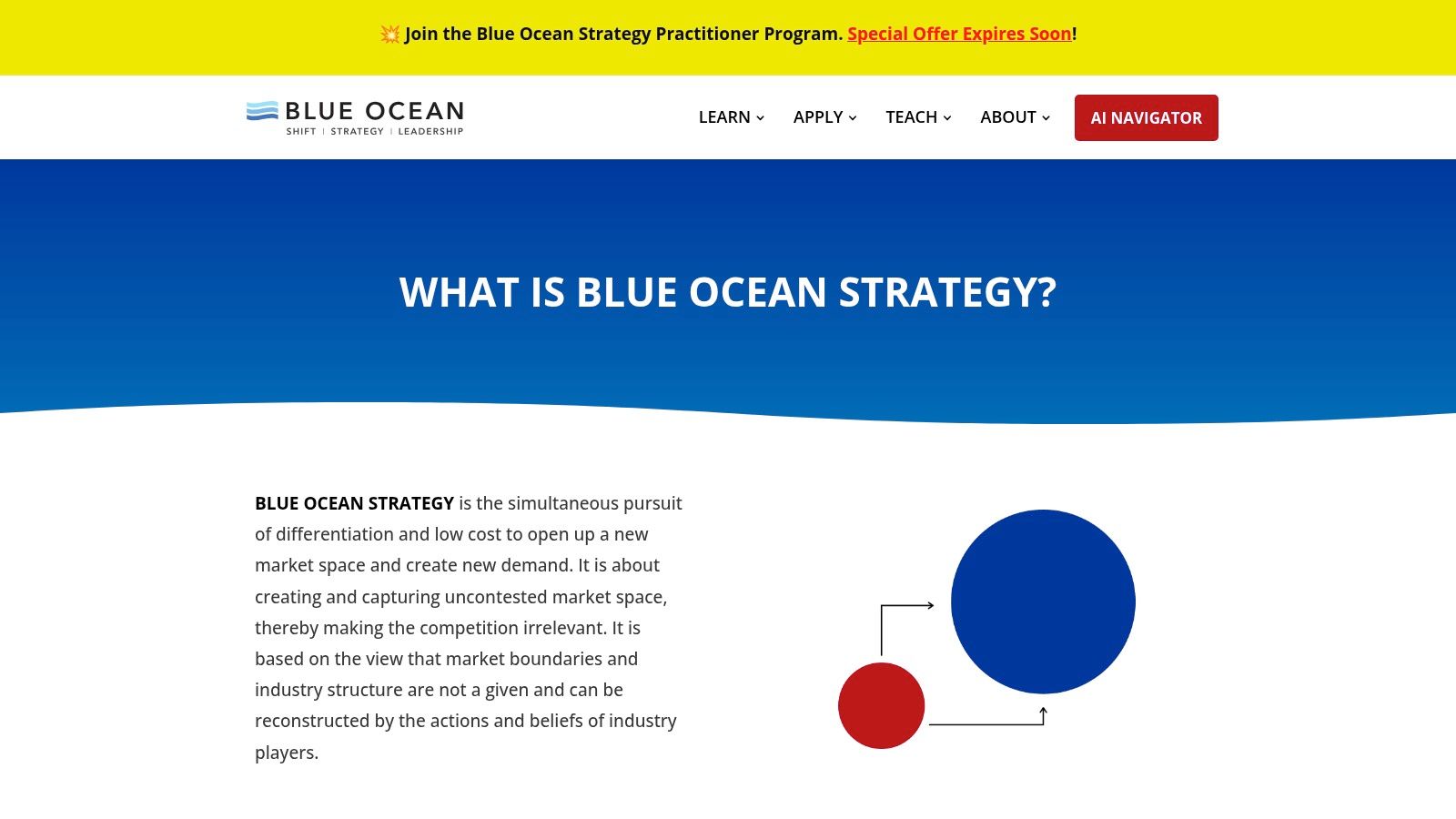
For leaders looking to disrupt their industries – CTOs, CEOs, startup founders, and entrepreneurs alike – Blue Ocean Strategy by W. Chan Kim and Renée Mauborgne presents a compelling framework. This book earns its place on our list by offering a practical methodology for creating “blue oceans.” These are uncontested market spaces brimming with opportunity, a stark contrast to the overcrowded and competitive “red oceans” many businesses find themselves battling in.
Instead of simply striving to outperform the competition, Blue Ocean Strategy emphasizes value innovation. This involves creating a significant leap in value for both buyers and the company itself, unlocking new and uncharted market territory.
Key Tools and Frameworks
Blue Ocean Strategy provides several tools and frameworks to guide this process:
- The Blue Ocean Strategy Canvas: This valuable visual tool helps map the existing market landscape. It allows you to analyze your offering against competitors’ across key factors, visually identifying opportunities to differentiate and create new value.
- The Four Actions Framework: This framework helps reshape your value curve by asking four crucial questions: Which factors should be eliminated? Which should be reduced? Which should be raised? And finally, which factors should be created that the industry has never offered?
- The Value Innovation Framework: This framework emphasizes aligning innovation with utility, price, and cost. It challenges the traditional trade-off between differentiation and low cost, encouraging a pursuit of both.
Practical Applications and Use Cases
- Startups: Blue Ocean Strategy offers a roadmap for new ventures. It helps define a unique value proposition and avoid direct competition with established players.
- Established Companies: This framework can revitalize existing products or services. It helps identify new growth avenues and break free from incremental innovation in saturated markets. Consider Apple’s introduction of the iPod and iTunes, a classic blue ocean move that revolutionized how we consume music.
- Non-profit Organizations: The principles of Blue Ocean Strategy can be applied to achieve social impact. They encourage addressing unmet needs and developing innovative solutions to complex societal challenges.
Implementation Tips
- Dedicate Resources: Implementing Blue Ocean Strategy requires a committed team and strong organizational support. It represents a significant strategic shift, not a quick fix.
- Start Small: Begin by applying the framework to a specific product line or market segment. Gain practical experience and internal momentum before expanding across the organization.
- Embrace Experimentation: Creating new markets involves inherent uncertainty. Be prepared to adapt, iterate, and learn from setbacks.
Pros and Cons
Pros:
- Comprehensive and research-backed strategic framework
- Practical tools for implementation
- Offers a new perspective on competition
Cons:
- Challenging to implement, especially in established organizations
- Requires significant buy-in across the organization
- Past successes may not be easily replicated
Learn more about Blue Ocean Strategy
While Blue Ocean Strategy doesn’t offer a guaranteed path to success, it provides a powerful and structured approach to identifying and capitalizing on untapped market opportunities. By challenging conventional strategic thinking and fostering a culture of innovation, organizations can create their own blue oceans and achieve sustainable growth. The book focuses on methodology and framework, not specific software or tools with associated pricing or technical requirements. The official website offers further resources and workshops.
8. Contagious: Why Things Catch On
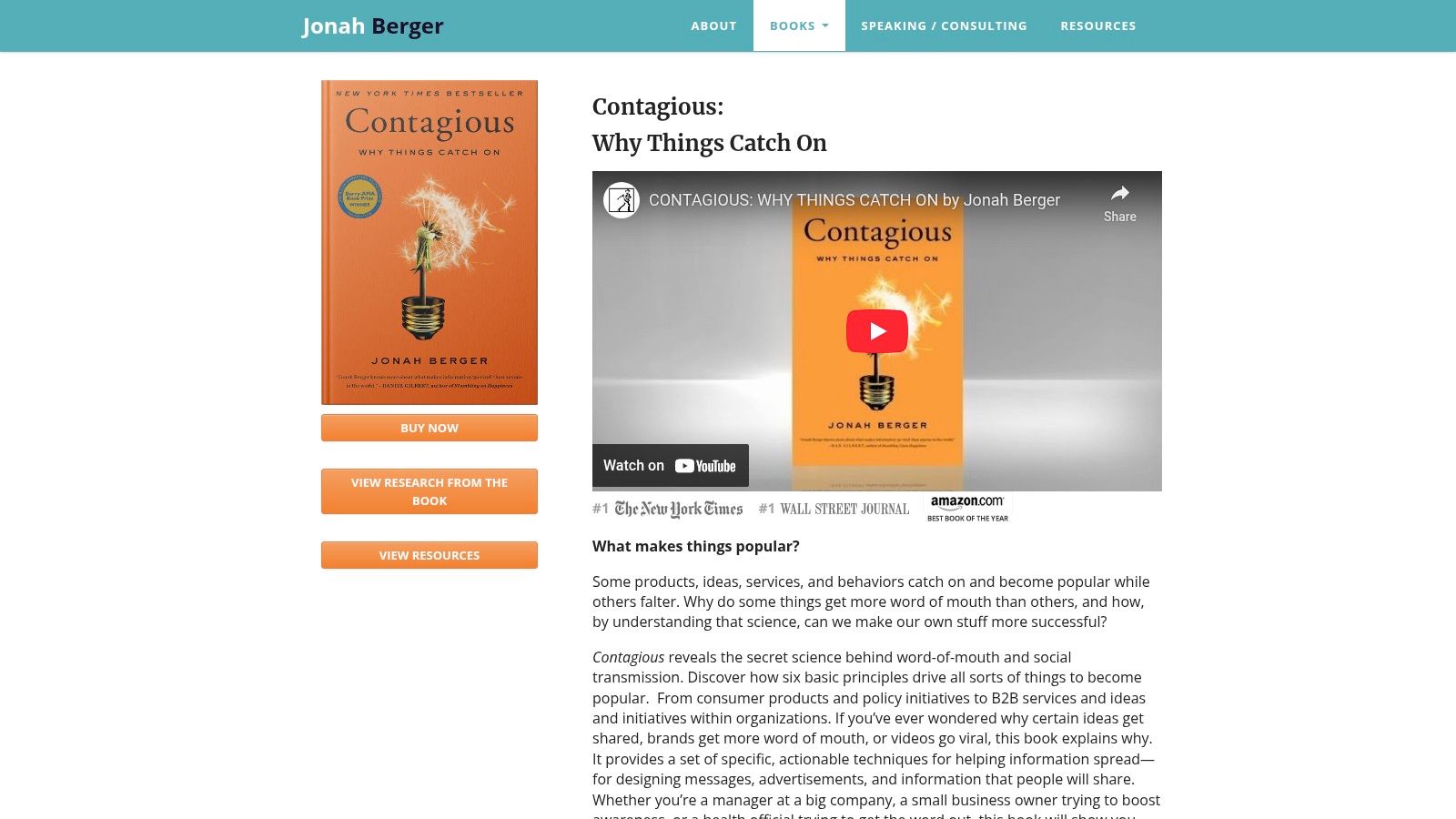
For CTOs, CEOs, Startup Founders, and Entrepreneurs, understanding why some products and ideas take off is essential for making a real impact. Jonah Berger’s “Contagious: Why Things Catch On” provides a practical, research-backed framework for building virality. This makes it an invaluable resource for anyone developing a product, service, or brand. This book earns a place on our list by offering actionable insights into how things spread through social networks, empowering you to create compelling content that resonates with your audience.
What sets this book apart? It introduces the STEPPS framework: Social Currency, Triggers, Emotion, Public, Practical Value, and Stories. This framework deconstructs the core elements that drive viral spread. Berger doesn’t simply present theories; he supports his points with engaging case studies and tangible examples of how to apply each principle.
Features and Benefits
- STEPPS Framework: This model gives you a structured approach to analyzing and building virality into your product and marketing efforts.
- Research-Based Principles: The book’s principles are rooted in scientific research, providing a reliable basis for understanding how things catch on.
- Actionable Techniques: “Contagious” offers practical advice and methods for applying each principle within the STEPPS framework, allowing you to easily put these learnings into practice.
- Real-World Examples: The book shares case studies of both viral successes and failures, giving you valuable takeaways and lessons.
Practical Applications and Use Cases
- Product Development: Use the STEPPS framework to create products with built-in viral potential. Think about how to weave Social Currency or Practical Value into your product’s core functions.
- Marketing Campaigns: Build marketing messages that trigger emotions, leverage social cues, and offer practical value. This will encourage sharing and generate buzz.
- Content Creation: Craft content that tells captivating stories and provides Social Currency, increasing the likelihood of it being shared and discussed among your target audience.
- Internal Communication: Apply the principles of contagiousness to enhance internal communications and build a more cohesive company culture.
Pros
- Grounded in scientific research, giving credibility to the strategies.
- Offers practical and actionable advice for immediate implementation.
- Uses an engaging storytelling style that makes complex ideas accessible.
- Applicable to a broad range of products, services, and ideas.
Cons
- The social media environment has shifted since the book’s release, so some tactics may need adjusting.
- The effectiveness of some principles depends on the particular situation.
- While the book offers a valuable framework, achieving true virality is still a complex undertaking.
Comparison with Similar Tools
While other books and resources explore marketing and virality, “Contagious” distinguishes itself through its research-driven approach and practical STEPPS framework. It offers a more structured and scientific method than general marketing guides.
Implementation/Setup Tips
- Begin by fully grasping the STEPPS framework.
- Analyze effective viral campaigns and determine which STEPPS principles were used.
- Test various tactics and monitor their results.
- Tailor the principles to your specific situation and audience.
Where to Find It
Website: https://jonahberger.com/books/contagious/
While pricing isn’t listed here, the book is widely available online and in bookstores. There are no particular technical needs to benefit from its insights. “Contagious” is a worthwhile investment for any leader aiming to broaden their reach and achieve substantial impact.
This Is Marketing: Seeing Through Your Customer’s Eyes
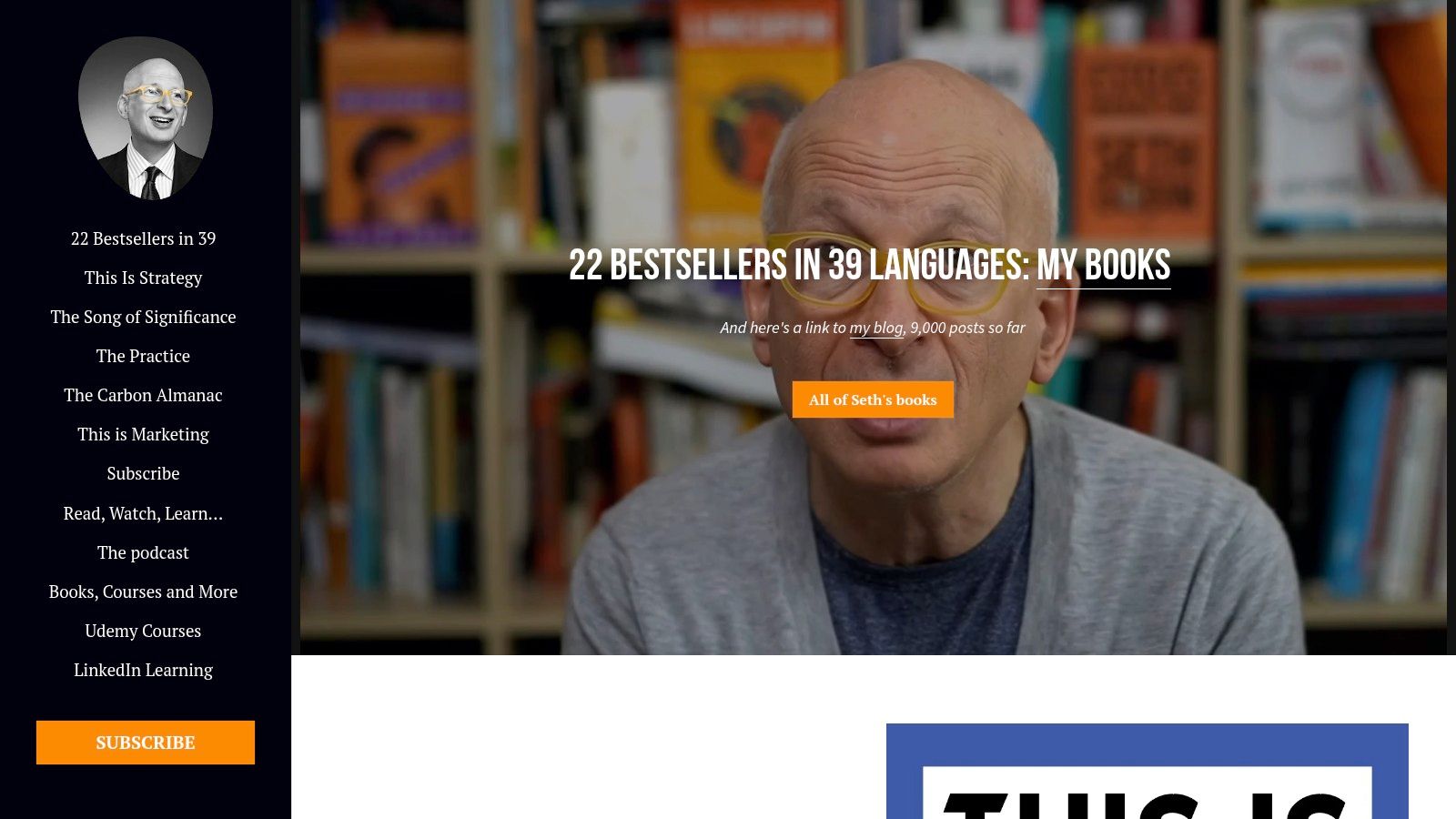
Seth Godin’s This Is Marketing: You Can’t Be Seen Until You Learn to See offers a valuable perspective for business leaders. Whether you’re a CTO, CEO, startup founder, or entrepreneur, this book provides a refreshing take on marketing. It moves beyond simple tactics and delves into the psychology of connecting with your audience.
This isn’t about manipulation. Instead, Godin focuses on truly serving your audience. This means understanding their needs, desires, and the cultural context surrounding your product or service. It’s about building genuine connections that lead to sustainable growth.
Practical Applications and Real-World Examples
- Finding Your Niche: The concept of the smallest viable audience allows you to concentrate your marketing efforts. This targeted approach maximizes impact, especially valuable for startups with limited resources. CTOs can then use this focused audience information to prioritize development efforts.
- Cultivating Loyalty: Building a loyal customer base is essential for long-term success. By focusing on value and trust, CEOs can create a community of advocates around their brand. Godin’s emphasis on ethical marketing further strengthens this positive brand image.
- Strategic Product Placement: For entrepreneurs, navigating a crowded marketplace can be challenging. This Is Marketing offers frameworks for effectively positioning new products or services. This clarity helps attract investors and secure those crucial early adopters.
- Crafting Your Marketing Message: Understanding status and affiliation dynamics is key to effective marketing. This book helps founders craft messages that resonate with their target audience’s aspirations and values, leading to stronger engagement.
Key Features and Advantages
- Permission Marketing: Build relationships by earning attention, not demanding it.
- Smallest Viable Audience Identification: Concentrate resources on a dedicated core group.
- Status and Affiliation Dynamics: Tap into the psychology of belonging to create compelling messaging.
- Brand Positioning Strategies: Define a unique space for your brand within the market.
- Ethical Marketing Principles: Prioritize customer well-being to build a sustainable business.
Pros and Cons: A Balanced View
Pros:
- Human-Centered Approach: Emphasizes genuine connection and value creation.
- Ethical and Sustainable: Promotes responsible marketing practices.
- Universally Applicable: Offers insights for businesses of all sizes.
- Concise and Impactful: Distills decades of marketing wisdom into an accessible format.
Cons:
- Less Tactical: Focuses on strategy over specific tactics.
- Requires Reflection: Some sections may require deeper thought and application.
- Long-Term Strategy: Building genuine connections requires time and effort.
Website
While the price varies depending on the format, the investment in this book is small compared to the potential returns. There are no technical requirements to access the content. Unlike tactical guides, This Is Marketing presents a holistic philosophy. It encourages a shift from interruption to connection. For the greatest benefit, dedicate time to reflect on the concepts and apply them to your specific business context. This book isn’t about quick wins, but about building a sustainable, value-driven marketing approach.
Building a Community-Led Business With Corey Haines’ Broke Through
In the competitive business world, a great product alone isn’t always enough. Building a thriving community can be the key to sustainable growth and true brand loyalty. Corey Haines’ Broke Through: The Actionable Guide to Building a Community-Led Business provides a practical roadmap for achieving this. This book stands out by offering a modern, actionable framework for using community as a core business driver, particularly for digital products and SaaS businesses.
This book isn’t theoretical. It’s based on Haines’ experience with successful brands like Baremetrics and SavvyCal. He breaks down building a community-led business into manageable steps. These cover everything from identifying your target audience and fostering engagement to monetizing your community and assessing its overall health.
Key Features and Benefits
- Community-Building Frameworks: Discover proven models for structuring and expanding your community.
- Audience Development Strategies: Pinpoint your ideal community member and attract the right individuals.
- Engagement and Retention Tactics: Learn how to keep your community active and invested.
- Community Monetization Models: Explore diverse ways to generate revenue from your community, beyond typical product sales.
- Analytics and Measurement Approaches: Track key performance indicators (KPIs) to understand community health and pinpoint areas for improvement.
- Actionable Templates and Worksheets: Put the concepts into practice with the resources provided.
Practical Applications and Use Cases
- SaaS Startups: Boost customer retention and gain new users through community advocacy.
- Digital Product Creators: Validate product ideas, gather valuable feedback, and generate pre-launch excitement.
- Established Businesses: Strengthen customer relationships and cultivate a loyal brand following.
Pros
- Up-to-Date Strategies: Addresses the particular challenges and opportunities of today’s digital businesses.
- Practitioner Insights: Benefits from Haines’ practical experience and valuable knowledge.
- Actionable Resources: Provides tools to instantly implement the strategies discussed.
- Combined Approach: Emphasizes the synergy between product development and community building.
Cons
- Digital/SaaS Focus: While the principles can be adapted, the main focus is on digital businesses.
- Limited Long-Term Case Studies: As a newer publication, long-term impacts haven’t been extensively documented.
- Time Investment: Building a thriving community requires consistent, dedicated effort.
Implementation Tips
- Define your target audience and their needs.
- Focus on building genuine relationships and providing value.
- Be patient and consistent. Community building takes time.
Pricing and Technical Requirements
The book is available in both physical and digital formats. See the website for pricing. No specific technical requirements are needed to implement the strategies.
Website: https://www.coreyhaines.co/brokethrough
Broke Through is a valuable resource for CTOs, CEOs, startup founders, and entrepreneurs wanting to leverage community to build stronger, more sustainable businesses. By implementing these strategies, businesses can move beyond transactional interactions and create a loyal following of dedicated advocates.
Stand Out Books: Key Comparisons
| Title | Framework ★ | Audience 👥 | Unique Selling Points ✨ | Value Proposition 💰 |
|---|---|---|---|---|
| Stand Out: How to Find Your Breakthrough Idea and Build a Following Around It | Step-by-step framework, case studies | Emerging thought leaders | Actionable & research-backed | Comprehensive guide for branding |
| Purple Cow: Transform Your Business by Being Remarkable | Remarkable product creation, differentiation | Innovative marketers & entrepreneurs | Memorable concept with real examples | Challenges conventional marketing |
| Made to Stick: Why Some Ideas Survive and Others Die | SUCCESS framework for sticky messages | Marketers & communicators | Science-backed, engaging storytelling | Practical sticky idea techniques |
| Steal Like an Artist: 10 Things Nobody Told You About Being Creative | 10 creativity principles, habit building | Creative professionals | Visual, easily digestible insights | Inspirational creative guide |
| Positioning: The Battle for Your Mind | Foundational positioning strategy | Business leaders & marketers | Timeless principles, clear focus | Impactful market positioning |
| Difference: The One-Page Method for Reimagining Your Business and Reinventing Your Marketing | One-page Difference Map, emotional focus | Brand strategists & innovators | Customer empathy-driven insights | Concise differentiation method |
| Blue Ocean Strategy: How to Create Uncontested Market Space and Make the Competition Irrelevant | Value innovation & market creation framework | Strategic leaders & innovators | Paradigm-shifting, research-rich approach | Systematic strategy for new demand |
| Contagious: Why Things Catch On | STEPPS framework for virality | Marketers & entrepreneurs | Science of social transmission | Actionable viral marketing tactics |
| This Is Marketing: You Can’t Be Seen Until You Learn to See | Permission marketing & audience targeting | Ethical marketers & business owners | Empathetic, humanistic approach | Deep, sustainable marketing wisdom |
| Broke Through: The Actionable Guide to Building a Community-Led Business | Community-building & engagement tactics | Digital/SaaS businesses | Practical templates with community focus | Up-to-date strategies for digital growth |
Elevate Your Marketing Game
These 10 essential marketing books offer a wealth of knowledge for revitalizing your strategies. They provide valuable insights into everything from crafting compelling stories to cultivating a loyal audience. However, selecting the right strategies and executing them effectively can be a challenge. Budget limitations, resource availability, and the expertise of your team all play a crucial role in successful implementation. Integrating these new concepts with your existing systems and workflows also requires careful planning.
When deciding which strategies from these books are right for you, consider your specific business objectives, your target audience, and the resources at your disposal. Start with small, manageable steps, experiment with different approaches, and closely monitor your results. Some strategies may require a larger investment than others, in terms of both time and money.
For example, developing a truly unique product, a so-called “Purple Cow” as described by Seth Godin, necessitates significant innovation and may involve research and development or product development costs. Seth Godin emphasizes the importance of remarkable products. On the other hand, implementing the “Made to Stick” principles outlined by Chip and Dan Heath can be achieved with focused messaging and adjustments to your content strategy. Chip and Dan Heath offer practical advice on making ideas memorable.
Compatibility with your existing brand is also key. Ensure that any new marketing approaches align with your current brand identity and overarching business strategy. Adopting a “Blue Ocean Strategy,” which involves creating uncontested market space, might require a substantial shift in company direction. W. Chan Kim & Renée Mauborgne are the authors of the influential book on this topic. In contrast, integrating Seth Godin’s principles from “This Is Marketing” could be incorporated more seamlessly into current operations.
Key Takeaways
- Focus on Your Unique Value Proposition: Determine what sets you apart from the competition and center your marketing efforts around it.
- Craft Compelling Narratives: Share stories that resonate with your target audience and create a lasting impression for your brand.
- Build a Community: Actively engage with your customers and foster a loyal following.
- Be Adaptable: The marketing world is constantly evolving, so be prepared to adjust your strategies as needed.
Ready to take your marketing to the next level and position yourself as a thought leader in your industry? Don’t just read about success—create it. Bhavik Sarkhedi & Co. empowers founders, CEOs, and entrepreneurs to break through the clutter and capture attention. We develop personalized branding and content strategies that deliver tangible results. Let us help you tell your story, build influence, and achieve enduring success. Visit us today to discover how we can enhance your brand and propel your growth.

